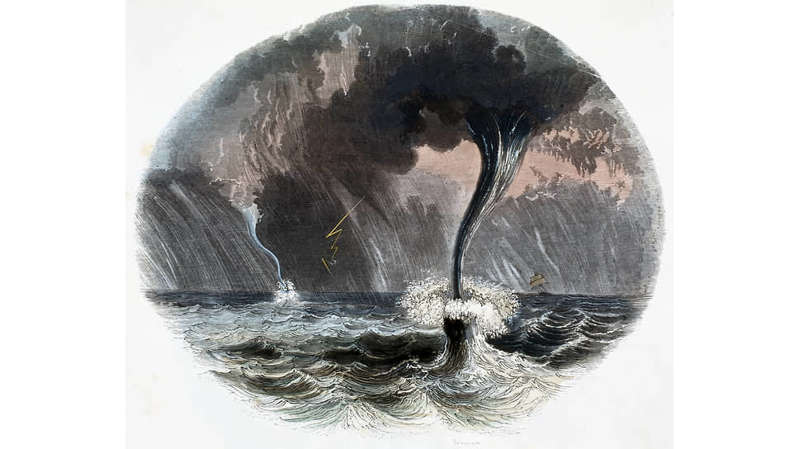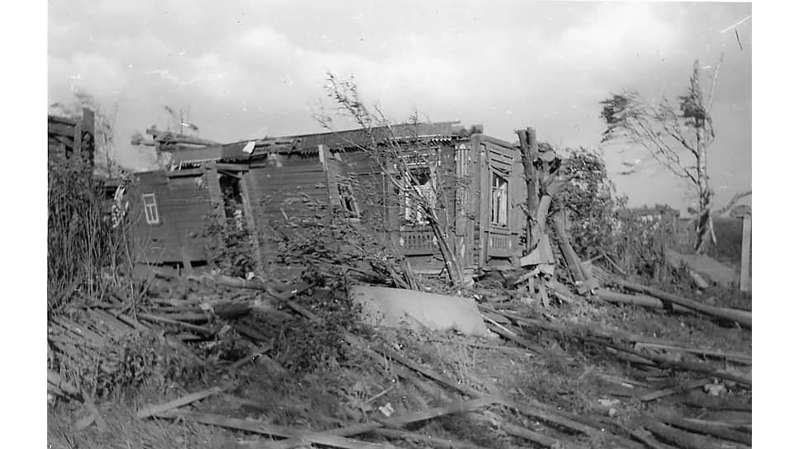
“A cyclone that unexpectedly brought so much destruction in our climatic zones is a rare, almost unprecedented phenomenon.”
How often do the rarest natural disasters occur?
70 years ago, on August 17, 1951, a hurricane of great force with hail and downpours, which led to casualties and destruction, passed over the settlements closest to Moscow. Moreover, this natural disaster was far from the only one that shook contemporaries, but later half-forgotten weather cataclysms. Including those in which thousands of people died.
“More than 3 thousand human victims”
From the publication of the newspaper “Tambovskiy Vestnik” about hurricanes on February 28 and March 1, 1914, March 4, 1914

“The wind speed reached 60-100, sometimes 200 meters per second!”
“Hurricanes in the south of Russia have caused a lot of disasters and misfortunes. In Yekaterinodar alone (since 1920 – Krasnodar – “History” ) over 1000 people died … “
From the publication of the newspaper “Russian invalid”, March 9, 1914
“Eyewitnesses of the catastrophe, who personally experienced it on the Yasenskaya Spit (a sand spit in the Sea of Azov, where sand was mined for railway construction. – “ History ” ), being impressed by what they had experienced, tell the following: the storm began at about 3 am. The sea was very agitated. By 4 o'clock in the morning, the workers of the quarry went to work. The sea was already becoming threatening. The engine operator of the ballast train offered to leave for Akhtari, but the workers saw nothing wrong with the roar of the storm. But then the moment, and the first wave crept onto the scythe, forcing the workers to think about saving their lives. Everyone was raised to their feet. Most, stripped down to their naga, rushed to the only hill where the bathhouse stood, while the rest were housed on a steam locomotive. The wind grew stronger and stronger, sending shaft after shaft to the scythe, one more terrible than the other. And then, unexpectedly, a strong squall flew in, tore the locomotive from the tender and threw it down a slope. The carriages, like wood chips, were scattered in different directions. Screams of horror echoed the Yasenskaya braid and then everything was quiet at once. People froze in horror. But a few seconds later a fierce struggle began for life, for a place where one could be saved …

“In 15 minutes, the famous Alazani Valley turned into a dump.”
Such a chilling detail is conveyed.
70 Persians fled to the barracks they occupied in order to seize the money they had hidden. When they entered the barrack, the pressure of the water reached its highest strength, the barrack crackled. Part of the Persians, about 20 people, managed to run out, the rest, together with the overturned barrack, were carried out to sea. Further, a new terrible picture. One of the Persians who had run out of the barracks grabbed a telephone pole. His comrades followed his example, and near the pillar, dug into the ground by 2 ½ arshins, a large group of people, distraught with horror, was formed, clinging to each other. Suddenly the pillar began to tilt, and in a moment the pillar, along with the Persians, was carried off into the sea; the Persians were killed. None of the 70 Persians were saved …
At 12 o'clock in the afternoon, the water began to go into the sea …
All those brought from the Yasenskaya Spit were buried in one mass grave under the canopy of one crudely made wooden cross. On March 3, 80 corpses were buried and on March 2 – 20, therefore, only 100 people … “
From the publication of the newspaper “Russian invalid”, March 9, 1914
“The cyclone that developed in the south and southeast of Russia, which unexpectedly brought so much destruction and took, judging by the preliminary telegraphic information, over 1200 human lives, in our climatic zones is a rare, almost unprecedented phenomenon. At least our meteorological stations have registered for the first time such a low barometric pressure – about 738-739 millimeters, and the wind speed – about 35 meters per second.
The cyclone originated in Western Europe near the Pyrenees, then moved through Italy to the northeast – to the Balkan Peninsula. After passing through the Balkan Peninsula and the Black Sea, the cyclone intensified: the barometric pressure dropped, the wind speed increased significantly.
Having caused destruction on the coast of the Sea of Azov, he moved further northeast to Astrakhan and to Tsaritsyn, and from here passed through Samara to the Urals …
Having descended over Siberia, the cyclone gradually dissipated and almost completely disappeared. The average speed with which the cyclone moved to the northeast, according to the main physical observatory, reached 50 kilometers per hour. “
From the publication of the newspaper “Russian invalid”, March 11, 1914
“Her Imperial Majesty Empress Alexandra Feodorovna Most mercifully deigned, on the 9th day of this March, to form a committee under her Personal Chairmanship to provide assistance to those who suffered from the storm that broke out on February 28 – March 1 in southern Russia, ordering this committee for the first time 50,000 rubles from the charitable funds at the disposal of Her Imperial Majesty … “
From the journal of the Novo-Nikolaevsk City Duma (Novo-Nikolaevsk in 1926 was renamed to Novosibirsk), March 18, 1914
“In the south of Russia, in places adjacent to the Sea of Azov, a hurricane caused a disaster, which entailed more than 3 thousand human casualties and deprived the local population of homes, tools of production and fishing.
The duty of philanthropy forces us to respond to the call of the people's need and grief (the Duma decided to allocate 1,000 rubles to help the victims. – “History” ) “.
From the most submissive report of the State Comptroller for 1914
“The total amount of extraordinary and additional loans for the ordinary section of the list was 70.5 million. rub., including … according to the estimates of the Ministry of Finance … to provide assistance to the population of the southeast of Russia, affected by the hurricane on February 28, 1914 0.3 mln. rub.”.
“The forest has been tumbled down”
From the report of the Minister of State Security of the USSR S.D. Ignatiev to the Secretary of the Central Committee of the All-Union Communist Party (Bolsheviks) G.M. Malenkov and Deputy Chairman of the Council of Ministers of the USSR L.P. Beria, August 17, 1951
“I report that according to the MGB Department of the Moscow Region, on August 17 of this year, at 5:30 pm, in the area of the villages of Skhodnya, Sokol and the villages of Golikovo, Chernaya Gryaz, Uskovo, Khimki District of the Moscow Region, there was a hurricane with heavy rain and hail, lasted for 20-30 minutes.
According to preliminary data, as a result of the hurricane in these settlements, a significant number of houses were destroyed and damaged, communications and power lines were disrupted.
There are victims in the village of Skhodnya.
At the Skhodnensky glass plant of the USSR Ministry of Aviation Industry, the roof was torn off, the plant's products (glass) were partially damaged and the fence was demolished. Part of the shops stopped working.
In the village of Chornaya Gryaz, the building of the village council, farm buildings and houses of collective farmers were damaged. The roof was demolished from the buildings of the Chernogryaz hospital. There are no victims among the sick.
For several kilometers, the forest in the area of the indicated settlements and villages has been tumbled down.
Groups of MGB and police operatives left for the scene … “
From a note of the Secretary of the Stavropol Regional Committee of the CPSU A.I. Vaskov to the Central Committee of the CPSU, September 1, 1954
“On August 27, 1954, a hurricane with a wind speed of 30–35 meters per second passed through a large territory of the region, accompanied by rainstorms with hail. The past hurricane caused great material damage to the collective farms of Vorontsovo-Aleksandrovsky, Georgievsky, Kursavsky, Mineralovodsky, Stepnovsky, Apollonsky and a number of other districts.
According to preliminary data, almost all crops of late agricultural crops have been destroyed in these areas: sunflower, corn, melons, vegetables on an area of about 11,000 hectares, as well as orchards and vineyards on an area of about 200 hectares.
Residential houses of collective farmers, livestock buildings and other outbuildings have been severely damaged. It was preliminarily established that about 1000 residential buildings, livestock and other premises were partially and completely destroyed. The blizzard spreads a large amount of roughened forage: straw, hay … “
“Unprecedented tornadoes have formed”
From the message of the USSR Ministry of Internal Affairs to the Central Committee of the CPSU and the Council of Ministers of the USSR, February 11, 1958
“During 8-10 February this year. in the Volga region and adjacent areas, cyclones passed, accompanied by heavy snowfall at low temperatures. As a result, there have been numerous deaths and damage to buildings; in some areas telephone communication was broken and power lines were damaged. According to preliminary data, 224 people died and about 120 people are missing.
Strong winds and snow drifts caused disruption of the movement of passenger and freight trains on a number of sections of the Ufa and other railways … “
From the essay by G. N. Bocharov “Grad”, published in 1985
“The hail that fell on the Alazani Valley was unprecedented – millions of white cobblestones from the sky! The wind is 90 kilometers per hour.
And then – a downpour. In essence, it was a meteorological explosion. Radars and rocket launchers in the hills, designed to shoot the hail clouds, were useless: vineyards, houses and roads – unprotected.
In 15 minutes, agricultural products alone were destroyed for 28 million rubles.
The rivers overflowing with downpours demolished more than twenty large and small bridges. In some villages, half of the houses were left without roofs. The front-line soldiers claim: the impression was that anti-tank shells were being fired at the tiles with direct fire.
In 15 minutes the famous Alazani Valley turned into a dump … “
From the speech of S.K. Cherkavsky, Head of the Department of Hydrometeorological Support of the National Economy of the USSR State Committee for Hydrometeorology, June 13, 1984
“On the European territory of the country on June 9, the atmospheric processes changed dramatically. An unusually deep cyclone for the summer, which was still in the morning in the north of Ukraine, began to quickly move through Moscow to the Volga-Vyatka region … On the way, the cyclone increased sharply and caused heavy rains and hail. The wind increased rapidly. At 15-17 o'clock in the territories of Ivanovo, Kostroma, Yaroslavl regions, unprecedented tornadoes formed … One of them (450 meters wide) passed through Ivanovo, having made a journey of 16 kilometers. I will say: this kind of destructive tornadoes, and even in such numbers, have not been in these areas yet. And judging by the destruction they caused, we can assume that the wind speed reached 60–100, sometimes 200 meters per second! (Later, various data were published on the number of deaths during this natural disaster – from several dozen to several hundred people. – “History” ) “.
Published by Evgeny Zhirnov
Read also:

